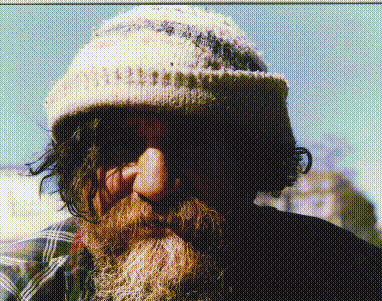 Man Guilty in
Man Guilty in
Swastika Graffitti
Incident
By Nancy Lewis
Washington Post Staff Writer
Saturday, MAY 11,1996
He stood before the jury, his brown hair pulled back into
a short ponytail that stopped just short of his homemade floor-length
aqua robe. A long shawl was draped over one shoulder, his feet
were shod with sandals.
Esededeea Aesfyza said he was praying that morning in the
middle of the Blizzard of '96 when two U.S. Capitol Police officers
happened upon him at New Jersey Avenue and D Street NW.
He was praying, his arm out stretched, to the swastika
painted on the traffic signal control box, Aesfyza testified.
He described it as a symbol that represents opposition to circumcision,
"mutilation" of young males, as he sees it.
But the two officers testified that on Jan. 8, Aesfyza,
surrounded by deep snow, was spraying a circle around the swastika
-- one that looked just like dozens of others that have appeared
around the city in recent months. It also looked like the swastika
the officers had just seen at the end of a set of footprints that
led to another traffic signal box a block away.
They found 13 cans of spray paint in his backpack, one
of which was the same color as the swastikas on the two traffic
signal boxes. Officials said they believe that Aesfyza painted
many, if not all of the dozens of swastikas throughout the city,
but he has been charged with only the two incidents. In recent
weeks, volunteers organized by the Anti Defamation League and
other groups have worked to remove many of the swastikas.
Aesfyza, 46, who lists a mailing address on Euclid Street
NW hut said he sleeps in alleys around Union Station, was charged
with two counts of defacing Public property, both misdemeanors.
Yesterday, a D.C. Superior Court jury convicted him of
the count that arose from the swastika painted at New Jersey and
D. But they acquitted him of painting the swastika on the second
traffic control box, rejecting Assistant U.S. Attorney Michael
Levy's argument that there was no doubt that the footprints in
the snow belonged to Aesfyza.
Judge Judith Bartnoff will sentence Aesfyza on June 24.
He faces a maximum of a year in prison and remains free pending
sentencing. Despite his requests, Aesfyza did not get his paint
back.
In a rambling colloquy with Bartnoff before final arguments--he
asked to make a closing argument in addition to the one made by
his attorney, Harold Peek--Aesfyza denied responsibility for the
swastikas on bridges and buildings that have appeared in recent
months.
"I would never do that," Aesfyza said..
Bartnoff prohibited him from making a separate statement
to the jury and admonished him to listen quietly during the arguments.
Horde | Suspect
| Erasing Hate | Swastikas

